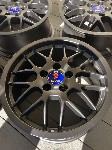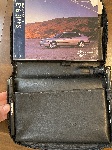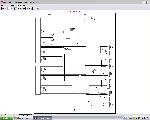
1964-1974 [Subscribe to Daily Digest] |
 1 Saabers Like This Post!
1 Saabers Like This Post!
Some time ago on the This bulletin board there was the following posting, “what’s the best way to rebuild the clutch master”, which I had responded to an gave the Beck/Arnely part #’s for the rebuild kits for the clutch slave (#071-0897) and master cylinders (# 071-1671). Previously to this I had experienced a problem with a leaking clutch slave cylinder (Girling # 64675083) on my 1971 Sonett. I had been able to fix the problem using a small ¾” brake cylinder hone, Varsol and a Beck/Arnely # 071-0897 rebuild kit, which crosses to the Lucas Girling kit #SP 2222. One of the readers of my response to the posting confirmed that the rebuild kit for the slave was correct, but also cautioned me and other readers that the kit for the master was not correct.
A few months later, as luck would have it, I began to have more problems with the clutch hydraulics. The car had only sat for two months and the clutch pedal went to the floor with out any resistance when I decided to go for a drive. I checked and noted that the fluid level in the remote reservoir had dropped significantly. After checking for any fluid loss at the slave cylinder, which happily I did not find, I carefully removed the driver’s side carpet and the driver floor’s insulating wallboard. This time it was the clutch master cylinder that was leaking as the driver’s side floor was wet with Dot 3 brake fluid. If DOT 3 or DOT 4 brake fluid (polyglycol fluids), which are corrosive are spilled onto paint, flushing with water and quickly wiping up the mess will not result in any damage. However, this long term leak had caused the paint to lift and allow rust to take hold on the exposed surface areas.
Now since I both had this questionable B/A master kit and needed to rebuild my clutch master cylinder I needed to look into this further. This style of Girling master was also used on the Saab 95 & 96 up to the end of 1968 when it was replaced with the Lockheed type, which has a round metal can type reservoir on top and was also used on the Saab 99. Although my Beck/Arnely parts catalogue does list kit # 071-1671 as being correct for the; 1969-74 Sonett, 1969-80 99, 1978 99T, 1986-90 9000 & 9000T, I compared the exploded diagrams of the Girling and Lockheed units in my manuals and noted that the internal components were completely different.
My Sonett spare parts catalogue indicates that both the Sonett V-4 and III's used horizontal style Girling masters and two different part #'s are listed (a cable system was used on the Sonett II). Part #73 13 760 was used up to chassis 70500050 (1970 unit #50) and part #74 23 213 was used from chassis 7050051 to the last Sonett made in 1974. The catalogue also lists two different cap part #’s (early and later units) and a separate plastic reservoir, which is only used with the later unit. Two different cap diagrams (later with a remote reservoir hose nipple, which the older unit does not have) are also shown. I am guessing that the only differences between the early and later masters cylinders is that later unit has an additional set of threads on the inside of the bowel for the different style cap.
After searching through some of my recorded notes of other brands and part #’s I found a recording of a Girling # SP 1963 kit. While trying to locate this kit my local NAPA parts store here in B.C. (Canada) found that this crossed over to Lucas #275, which also crossed over to their NAPA #1016.
A day later I had the NAPA kit for a close-up comparison with the B/A kit. Contained inside the NAPA kit's cardboard box was a plastic bag with the logo PBR, which contained the parts, assembly grease and instructions. The tag on the bag reads 63-1016 Australia 7-24-03. Although the kit, according to the instruction sheet, is a "universal kit" it contained the correct size (1 3/8" OD) rubber dust cover "P 4632 41", a plastic thimble (a metal reusable type was on my master), and three rubber seals. The kit contained a thick seal "P 4330 20" (which I used), a slightly thinner seal "P 6968 24", an even thinner three sided seal with a large hole "P 7076 10", and a small cup-shaped “valve stem” end seal with a small hole, which had an outer single-ringed edge with no visible markings or #'s (which I also used),. From my master’s piston assembly I recorded the old piston seal # "64673892 E.W. 63" (from another Sonett clutch master I recorded "64673892 E.W. 86"). From the valve stem I removed a small cup-shaped valve stem end seal, which matched the one in the kit. The condition of both the old piston and valve stem seals were the same, they had swelled and crumbled when being removed.
My Beck/Arnely kit, which is marked Made in Great Britain contained a rubber dust cover approximately 1 1/16" OD (which is too small), one piston seal marked "Made in England ZKH" (which may or may not work in the Girling unit) and a stem seal marked "Made in England OAB 5/8" (which is too large and cup shaped). The B/A kit is no doubt suitable for the later Saab model 95 & 96's with the Lockheed clutch master as well as the 1969-80 99, 1978 99T, 1986-90 9000 & 9000T as indicated in the Beck/Arnely parts catalogue, but this kit is not suitable for the V-4 Sonetts or the pre-1969 95 & 96's, which also have a Girling clutch master cylinder.
From the driver’s side of the engine compartment, with the air cleaner assembly removed and a trouble light positioned on top of the transaxle, I removed the clutch hydraulic assembly as follows:
1. I started by draining the clutch reservoir’s fluid using the slave cylinder’s bleeder using a 7/16” boxed-end wrench. With my girlfriend, Jen, assisting by slowly pushing the clutch pedal I opened the bleeder as the pedal dropped to the floor and closed it prior to her lifting off the pedal to raise it back. I repeated this until it was empty.
2. From inside the driver’s compartment I disconnected the push rod from the clutch pedal by removing the locating pin (after removing its cotter pin and washer) and loosened the top nut, which secures the clutch master.
3. Next from the engine compartment, I removed the bottom ½” nut holding the clutch master, which is mounted onto a fire wall stud. I used a 3/8”drive socket wrench with a 6” extension.
4. Then I removed the Philips screw bolt and 3/8” nut which holds the clutch reservoir to the inner fender plate bracket and disconnected the reservoir from the reservoir line. Although there was a fuel type hose clamp I had to cut the line as the clamp was badly rusted and the line was well weathered. I later replaced this 12” hydraulic line with a 14” piece of 5/8” brake fluid compatible hose for under $3.00. I replaced the two hose clamps from a Motormite “HELP!” #55172 package with two of the # 14 (9/16”) fuel hose clamps. The $7.00 package contains six 5/8” and six 9/16” clamps and was on one of the turn-style racks at my local auto parts supplier.
5. I released the brake and clutch hydraulic reservoir lines from the securing tab on the fire wall and pushed them out of my view as described below.
6. While looking down through the clearance between the steering rack’s bellows and the fire wall I could just see the head of the top bolt. With a 6” long ½” open-end wrench I was able to hold the bolt head, while Jen removed the ½” nut and washer from inside the driver’s compartment with the 3/8” socket wrench with a 6”+2” extension.
7. With a ½” boxed-end wrench, I next removed the slave cylinder from the transaxle. Note that some slave cylinders have a shim between them and the transaxle casing.
8. The remaining clutch hydraulic assembly was then free to be removed. This was accomplished while feeding the reservoir line down through the clearance between the steering rack’s bellows and the fire wall. Note: As you remove the master watch and write down exactly where you will need to feed this line for reinstallation. The master cylinder could be turned once the push rod’s dust cover was free of the mounting hole in the fire wall. Turning the top of the master slightly towards the transaxle and careful guidance of the unit with the attached reservoir line past the brake master’s components/wires was required.
9. Note: I recorded the angle position that the slave cylinder’s hydraulic line was in relation to the clutch master’s body and with a 7/16” flare nut wrench I removed the line from the clutch master.
10. Next, using the 7/16” flare nut wrench I removed the hydraulic line from the slave cylinder’s line adapter
11. With the 7/16” flare nut wrench and a 15mm open-ended wrench I removed the hydraulic line adapter and copper washer from the slave cylinder.
12. I then removed the reservoir line and using a large pair of channel lock pliers I removed the clutch master’s cap.
13. After removing the dust cover, cir-clip and push rod from the master I was able to remove the valve assembly by tapping the valve end of the body down onto a small piece of 2 x 4 wood.
14. With the 7/16” flare nut wrench I removed the break bleeder.
15. I then cleaned and/or soaked everything over night using brake cleaner. Note: The rebuild instructions state, "do not hone the cylinder".
16. The next day as I followed the rebuild kit’s instructions I completed the rebuild.
I reinstalled the clutch hydraulic assembly as follows:
1. With the new reservoir hydraulic line mounted and secured with a new clamp I replaced the mounting bolt into the upper mounting hole of the clutch master and secured the bolt in place with a piece of masking tape.
2. I protected the open end of the reservoir line from debris with tape and guided it up through the clearance between the steering rack’s bellows.
3. Next, I carefully guided the master with the attached slave cylinder and line past the brake master’s components/wires Note the comments in step 8 above.
4. From inside the driver’s side, Jen guided the push rod through the mounting hole in the fire wall and temporarily attached the clutch pedal to the rod.
5. Then as I turned and pushed the master Jen guided the clutch master’s dust cover end and the mounting bolt end through the mounting holes.
6. Using a small piece of masking tape placed around the inside of the ½” socket, to hold the nut securely, I reinstalled the bottom ½” nut using the 3/8” drive socket wrench with a the 6” extension.
7. I was again able to see and hold the top bolt head by looking down through the clearance between the steering rack’s bellows and the fire wall. And while I pushed against the bolt Jen reinstalled the washer and ½” nut from inside the driver’s compartment. A new cotter pin was then installed into the clutch pedal’s locating pin.
8. Next I mounted the slave cylinder onto the transaxle.
9. Then I reattached the clutch reservoir to the reservoir line and inner fender plate bracket.
10. I filled the reservoir with DOT 4 fluid as I wished to convert from DOT 3 fluid.
11. After several repetitions, with Jen assisting by firstly pumping then slowly pushing the clutch pedal as I opened the bleeder (while the pedal dropped to the floor and closing it prior to her lifting off the pedal to raise it back) I bled the air out of the clutch. NO leaks now and it works and feels great!
I still intend to purchase the Girling SP1963 kit to compare it with the NAPA kit as it may be more application specific.
Brake fluids:
Both DOT 3 and DOT 4 fluids are also hygroscopic, meaning they absorb moisture ! In fact they will suck moisture right through the pores of a cast master cylinder. If you fill a bottle cap to the brim with this type of fluid and leave it over night it will have absorbed enough water to cause it to over flow! Absorbed water in the brake fluid can contribute to corrosion of parts such as the caliper’s steel pistons. In a well sealed brake system, like those on the typical passenger car, the fluid will require changing about every 1-2 years. As the amount of moisture absorbed increases, the point at which the brake fluid boils decreases. Brake fluid with a reduced boiling point (or high water content) can create vapor by boiling in the caliper, or wheel cylinder. Although DOT 3 fluid is rated at greater than 401oF MDBP (minimum dry boiling point), in a typical 3 to 4 year old car with 3 to 4% moisture content, it may boil at 284oF MWBP(minimum wet boiling point). The result is sudden brake failure! I had thoughts of changing and cleaning everything to use silicone based synthetic DOT 5 brake fluid, but I choose instead to use DOT 4. DOT 3 and 4 can be mixed. DOT 4 fluid is rated at greater than 446oF MDBP and 311oF MWBP.
DOT 5 is a silicone based synthetic and is rated at greater than 500oF MDBP and 356oF MWBP. Silicone has none of the problems of DOT 3 or Dot 4 fluid as I described above because it does not absorb moisture. It is not hygroscopic and it does not attack paint since it is not corrosive, so spillage is not a problem. Unfortunately, it is extremely expensive often costing 5-10 times as much as polyglycol fluids. More importantly, the compressibility of silicone fluid is very unstable throughout the temperature range encountered in normal usage. Therefore, as the fluids temperature increases, the pedal-travel necessary to compress the fluid changes, resulting in an unpredictable pedal height. Although DOT 3 and 4 can be mixed, DOT 5 should never be mixed with any other fluid.
Quickly becoming the fluid of choice for race cars, DOT 5.1 is a newer brake fluid with improved characteristics for moisture absorption and compressibility. This fluid can resist moisture contamination longer and provide superior performance for severe use and can be safely mixed with either DOT 3 or 4.
For adding to your records:
GIRLING # SP1963 – (Lucas #275) Clutch master cylinder repair kit fits Saab 95 & 96 Saab V4 Saab 97 Sonett with Girling unit. Also fits certain applications for: Triumph Herald - Spitfire - Lotus - Lotus elite - Ford Cortina - Hillman - Hillman imp - Sunbeam - and others! Also Lucas #275 and NAPA #1016.
Lockheed # SSB936 – (#1256) Clutch master cylinder repair kit fits Saab 95 from 1969 through 1970, and 96 from 1969 through 1970 with Lockheed unit; Hillman Super Minx from 1962 through 1967. Also Girling 682 LSSB 123 and Lockheed LK 11238.
GIRLING # SP2222 –Clutch slave cylinder rebuild kits fits Saab 95 & 96 Saab V4 Saab 97 Sonett. Also Beck/Arnely # 071-0897 1969-74 Sonett, 1965-68 95 & 96, 1969-80 99, 1978 99T, 1986-90 9000 & 9000T.
posted by 24.66.16...
 1
1
No Site Registration is Required to Post - Site Membership is optional (Member Features List), but helps to keep the site online
for all Saabers. If the site helps you, please consider helping the site by becoming a member.
 |
 |
 |
 |
 |



